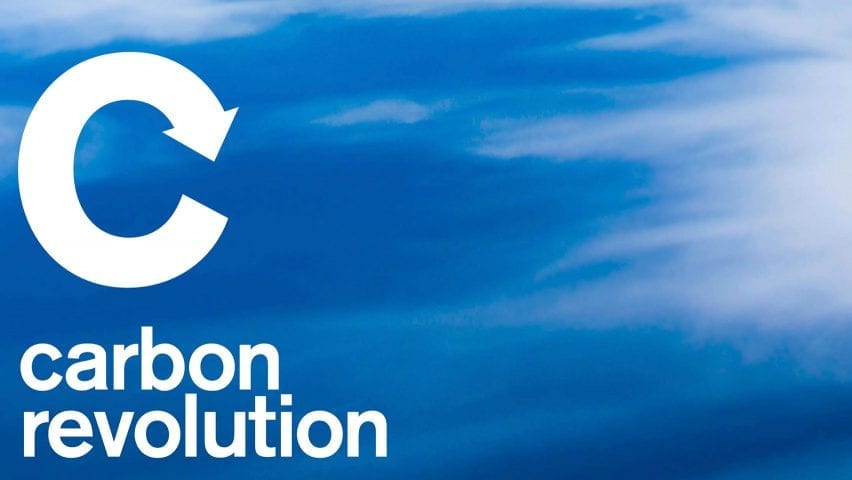As we reach the end of the first week exploring the carbon revolution, here are 10 highlights from our research so far including carbon-neutral concrete and machines that suck CO2 out of the sky.
Carbon-neutral concrete
Montreal company Carbicrete is exploring ways of using industrial waste to create carbon-neutral concrete, potentially offering a solution to the huge carbon footprint of the cement industry, which is responsible for an estimated eight per cent of anthropogenic CO2 emissions.
"We're taking CO2 out of the system every time we make a block," Carbicrete CEO Chris Stern told Dezeen.
Read our interview with Stern ›
Olivine sand
Dutch designer Teresa van Dongen has created a library of products that capture atmospheric CO2, including olivine, an abundant mineral that can absorb its own weight in carbon.
"It absorbs CO2 very easily," van Dongen told Dezeen. "One tonne of olivine sand can take in up to one tonne of CO2, depending on the conditions. You just have to spread it out and nature will do its job."
Read our interview with van Dongen ›
Direct air capture
Swiss startup Climeworks builds direct air capture machines that suck CO2 out of the sky. The greenhouse gas can be buried underground or is in products including fuels, foods and construction materials.
"We capture CO2 from the atmosphere," said Christoph Beuttler, head of climate policy at Climeworks. "We're mining the sky because there's too much carbon in it. And it's a sustainable resource."
Read our interview with Beuttler ›
Climate-neutral cars
Electric-car brand Polestar is striving to build a vehicle that generates zero emissions anywhere in its supply chain by 2030.
"This is truly a moonshot goal," the brand's head of sustainability Fredrika Klarén told Dezeen. "We're putting the goal out there and then we're building the roadmap as we go along."
Read the interview with Klarén ›
Renewable energy
UK renewable energy supplier Bulb is helping the nation switch away from fossil energy.
"We're now at a starting point where we're beginning to see many, many more homes become participants in that two-way grid," Wood told Dezeen.
Read our interview with Wood ›
A new carbon marketplace
Seattle start-up Nori is building an online marketplace that incentivises people to capture and sell atmospheric carbon.
"If we want people to do something they're not currently doing, the best way to get them to do it is by paying them," Nori CEO Paul Gambill told Dezeen.
"So what we need is a financial incentive for pulling carbon out of the air," he said.
Read the interview with Gambill ›
Shopify's Sustainability Fund
E-commerce platform Shopify is spending $5 million per year to help fledgling businesses including Climeworks and Nori scale up. It is sharing its research on its website to help others learn about potential solutions.
"We want to be able to use our $5 million annual climate fund to kickstart demand in carbon removal," said fund director Stacy Kauk.
Read the interview with Kauk ›
Net-zero furniture
Danish furniture brand Takt is using design to eradicate carbon emissions from its products and expects the entire company to be net-zero within two or three years.
"We can calculate the expected CO2 footprint of a product when we see the first drawing," founder Henrik Taudorf Lorensen told Dezeen. "We start to reengineer the products at that point."
Read the interview with Lorensen ›
Turning emissions into products
Australian company Mineral Carbonisation International buys CO2 from polluting factories and turns it into construction materials.
"Our aim is to lock a billion tonnes of CO2 into usable products by 2040," said MCi's chief operating officer Sophia Hamblin Wang. "We turn waste into new products."
Read the interview with Hamblin Wang ›
Carbon-negative architecture
This year's Serpentine Pavilion sequesters more atmospheric carbon than it emits, making it a carbon-negative building.
"The total cradle to grave embodied carbon emissions of the pavilion are -31,000 kg of CO2 equivalent," according to a life cycle assessment of the project prepared by construction consultant AECOM.
Read our interview with the AECOM team ›
Carbon revolution
This article is part of Dezeen's carbon revolution series, which explores how this miracle material could be removed from the atmosphere and put to use on earth. Read all the content at: www.dezeen.com/carbon.
The sky photograph used in the carbon revolution graphic is by Taylor van Riper via Unsplash.

